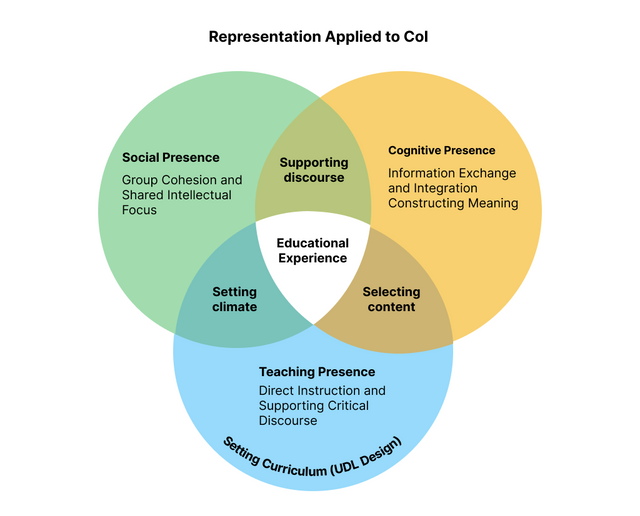Representation and the Community of Inquiry Model
Let’s return to the second principle of UDL and use the Community of Inquiry model to explore multiple means of representation and equity education.
Selecting content that models decolonizing practices and representing this in multiple ways is the emphasis of this principle. In terms of supporting an online Community of Inquiry, shared intellectual focus between learners engaged in discussions, brainstorming, or study dyads or groups is enhanced when students have access to multiple means of constructing meaning from the content. Modelling questions that draw out critical discourse (used either by you or your students to demonstrate curiosity), interactive inquiry, and metacognition are all integral to the process of learning. This revised Bloom’s Taxonomy may offer you some ideas of wording for these questions.

Social Presence
- Does the collaborative environment invite student exchange through a variety of mediums (audio, visual, text, language/symbols, etc.)?
- Are diversity and lived experience integrated into student exchange in ways that promote new learning and solidarity?
- Do student exchanges go beyond purely social, and beyond quantity, to deliberate communication with shared intellectual focus?
- Do the technological tool choices promote social presence in the course in an accessible way?
Cognitive Presence
- Are there a variety of means for diverse students to experiment with concepts and meaning construction?
- Do opportunities for problem-solving acknowledge social identities and power structures that shape critical interaction with materials?
- Are there opportunities and options for problem and solution identification?
- Are options for information exchange stemming from a foundation of inquiry (vis-a-vis each other and between students and teachers)?
Teaching Presence
- Is the distinction between direct instruction and facilitation clear and balanced in application?
- Do developmental options (scaffolding) assist students in identifying gaps in their knowledge? Do they support critical discourse and help make sense of complex information?
- Are options for inquiry and question design represented in a variety of ways?
- Does the feedback provided support action-oriented learning and the scaffolding of the course?